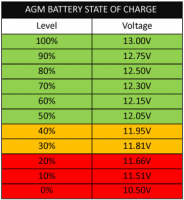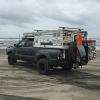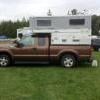When do you recharge?
#1

Posted 05 June 2017 - 11:28 AM
#2

Posted 05 June 2017 - 12:23 PM
If it works like my BlueSeas version, you don't really have to do anything. The only issue is if you run the battery too low, it will not allow the camper battery to charge; it thinks there is an issue w/ the camper battery. The separate (as the name implies) only allows charging in one direction so you don't discharge the main battery. It will also turn of the charge when the battery is at some thereshold so it doesn't overcharge.
Boise, ID
2022 Chevy 3500 HD
2023 FWC Flatbed Hawk
#3

Posted 05 June 2017 - 02:52 PM
When we picked up our fleet at the dealer in April, they advised to keep on eye on the zamp solar charge controller. The separator kicks in when the readout gets down to about 12.4. I've parked for up to a week in the garage (out of the sun) with the kill switch out and have never seen the zamp go below 12.7.
Now my question - how do you (or do you) manually reset the separator ?
#4

Posted 05 June 2017 - 03:15 PM
To find out how the sure power battery separator works you should look at the manual. FWC has many manuals on their web site here is the one for the battery separator; http://www.fourwh.co...arator1315.pdf the model is 1314 and the 2 options (8+9) are not used.
#5

Posted 05 June 2017 - 06:29 PM
Thanks DavidO. The manual I was looking at (FWC) didn't really address my questions, maybe it was an old version or something. I will check your link.
Update -
Turns out it was the same manual...... so I guess to better phrase my question, if the battery gets too low as noted in kmcintyre's post, and now it won't allow a charge, do you just put it on a 110v charger to get it back to where it needs to be and then the separator resets itself or is there something manually you have to do to reset the system so it will allow off the truck charging again?
Edited by Longbeard87, 05 June 2017 - 06:36 PM.
#6

Posted 05 June 2017 - 07:25 PM
if the battery gets too low as noted in kmcintyre's post, and now it won't allow a charge, do you just put it on a 110v charger to get it back to where it needs to be and then the separator resets itself or is there something manually you have to do to reset the system so it will allow off the truck charging again?
Yup, just charge them from shore power until the separator thinks it is safe to reconnect them.
2012 ATC Puma Shell build - https://www.wanderth...012-puma-build/
Power considerations thread - https://www.wanderth...e-power-scotty/
Building out an electrical system - So, you want to setup a good electrical system in your camper? - Electrical, Charging, Solar, Batteries and Generators - Wander the West
#7

Posted 05 June 2017 - 07:26 PM
Just recharge with shore power or solar until the voltage is high enough for the separator to work. That's why I swapped my separator for a Bluesea ACR, so I have some manual control over things plus it also allows the solar to charge the truck battery if the camper battery is fully charged.
#8

Posted 05 June 2017 - 07:55 PM
Longbeard, the simple answer is that there is no way to "reset" the system manually. Many owners have switched out the separator with a Blue Sea system. DrJ did a nice write up on that upgrade here http://www.wanderthe...ery-isolator/
The system he picked did have a simple switch to turn charging on even if the camper batteries were to low for the automatic switching.
If you have a solar system that can provide enough power to get your voltage up. Changing the wire size (larger wire) from the truck battery to the separator can help the separator stay connected as the voltage drop will be less. You can also install a switch to bypass the Separator something like this. https://smile.amazon...ZXVV4M1CTY9TW2
Just be sure to turn it off before you shut down your truck.
#9

Posted 05 June 2017 - 10:18 PM
Ok. Thanks for all the help. I am getting a real education on how this works. Much appreciated. I was checking everything out and I do have a BlueSea ACR unit. I guess what I got confused on was how you get things going again if you run the battery too low. I thought there was some sort of manual reset but I guess what they meant was I had to "manually" hook up a charger and get it back up before the unit will allow the truck to charge it again. Thanks.
#10

Posted 06 June 2017 - 06:38 AM
 I agree that battery charge management is a PITA and the last thing that we want to be hassled with when all we want to do is enjoy the outdoors in our FWC. So to keep things as straightforward as possible, here are some things to keep in mind.
I agree that battery charge management is a PITA and the last thing that we want to be hassled with when all we want to do is enjoy the outdoors in our FWC. So to keep things as straightforward as possible, here are some things to keep in mind.
It is important to monitor your camper battery's state of charge but there is no simple "gas gauge" way to know how full your battery is like there is for your truck's gas tank. You can, however, come close to a "gas gauge" for your battery with an inexpensive digital voltmeter that you touch to your battery's terminals for a voltage reading. BUT, and this is a big BUT, to make an accurate one-time state-of-charge voltage reading you have to make sure that the battery is not being charged nor is a load connected to it. AND, for maximum accuracy, the battery should have been disconnected from a charging source or a load for an least a couple of hours! (And who can afford to do that when camping?)
Nevertheless, I strongly urge everyone to regularly monitor their camper battery's voltage even though it may be being charged or discharged. You will learn over time to pretty accurately estimate the state of charge of your battery by watching the voltage. Sure, if you want to get fancy you can install a Trimetric or other device that calculates state of charge by measuring amperage in and amperage out, but these devices are expensive and require careful installation and calibration.
I am attaching a battery state of charge chart for use with AGM batteries (the type of deep cycle lead acid batteries most commonly used in RVs). A new AGM battery when fully charged will measure close to 13 volts. And, again, remember that this is for a battery that is not being charged (because the voltage will appear to be higher) and not under load (a battery supplying electricity to an appliance will test at a lower voltage than it will test after the load is removed).
Nevertheless, it is good to make friends with your battery by regularly checking the voltage. You will learn over time how long you can run your regular appliances without depleting your battery too far. To avoid unduly shortening the life of your battery you should not let the battery discharge more than 50%. Referring to the chart, this means to not let the battery voltage drop below about 12 volts. But remember, this voltage measurement accurate only when nothing is charging or loading the battery because either will give false state-of-charge readings.
Solar panels, shore power and power from a running truck's alternator are all ways to charge the battery. Each have their disadvantages and advantages. Shore power may not be available; the solar panel may not be in direct sunlight; the length and small size of the wire from the engine compartment to your camper battery may prevent a high enough voltage to get to your battery to fully charge it. But we do the best we can, keep an eye on the voltage, and have fun outdoors!
Ed
Edited by esimmers, 06 June 2017 - 06:44 AM.
0 user(s) are reading this topic
0 members, 0 guests, 0 anonymous users


















